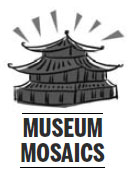From rags to riches
By Zhang Kun (China Daily) Updated: 2013-01-14 16:41 |
|
The Pearl Pillar of the Buddhist Shrine is tower-shaped and features engravings, precious gems and other fine decorative elements. Photos Provided to China Daily |
|
 |
Three young treasure-hunters got lucky and made an important discovery at a deserted pagoda in Suzhou, Jiangsu province, on April 12, 1978.
According to Suzhou Museum, the three boys, all under 9, broke into the shuttered Ruiguang Pagoda to catch sparrows and collect their eggs.
They pushed aside some dried grass and found a slate slab, which they pulled up, revealing an alcove containing two Buddha statues.
The clay statues were brightly colored and so fascinated the children that they wrapped them up in rags and took them home.
Proudly, they showed off their treasures, but the villagers were worried they would be in trouble for damaging State relics.
So, their parents informed local officials, who contacted Suzhou Museum. The institution investigated further and soon made plans for restoration of the building.
Ruiguang Pagoda was originally part of a temple that was built around 241 AD. According to documents found in the temple, the pagoda was built from 1004-1030, when the temple was named "Ruiguang" (which means "auspicious light").
The temple was repeatedly destroyed and restored over the years, until the Taiping Rebellion in 1863, when heterodox Christian rebels destroyed many Buddhist and Taoist temples and statues. Ruiguang Temple was completely destroyed this time, leaving just the pagoda.
By the 1950s, the pagoda was closed because of safety fears. It was not until after the children found the statues that repairs were carried out and completed in 1990. It has been open to the public since then.
The pagoda is a fine example of old Chinese architecture. About 53.6 meters high, it has seven stories and each roof was constructed so it had eight angles.
The building has stone sculptures of lions, clouds, and people; and visitors can now climb all seven levels of the building.
"It's a fine example of a brick-wood tower from the Song Dynasty (960-1279) and an important example of how towers evolved in the Yangtze Delta," says Wang Huixiang, a curator at Suzhou Museum.
Among the findings at Ruiguang Pagoda, the most significant is the Pearl Pillar of the Buddhist Shrine.
- China eyes life expectancy of 79 by 2030
- Air monitor stations growing independent
- PLA taps online power with Dream Class
- Steps taken to 'speed up' corrupt fugitives' return from US
- Strict new Party rules on the way for officials and ordinary workers
- Winter smog control made a top priority
- KMT leader to make trip to mainland
- Drones for monthslong missions in the pipeline
- Govt applicants seek some jobs, spurn others
- 1,171 foreign students lose govt scholarships












